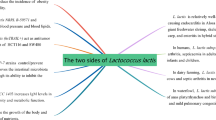Abstract
The anaerobic and aerobic bacterial flora from the spiral intestine of hatchery-raised sturgeon were enumerated. Among the obligate anaerobes, a new bacteroidelike organism was isolated and found to be the predominant strict anaerobe. The organism is Gram-negative, produces the fermentation products acetate, succinate, propionate and H2. The mol % G+C of DNA from various strains ranged from 33.17–33.65. The optimum sodium concentration for this organism was found to be 137 mM; the sodium level in the sturgeon spiral intestine ranged from 94.5–110.0mM. Based on these and other physiological characteristics, the organism appears to be a new species of the genus Bacteroides.
Similar content being viewed by others
Abbreviations
- GI:
-
Gastrointestinal
- VFA:
-
Volatile fatty acid
- SI:
-
Spiral intestine
- GLC:
-
Gas-liquid chromatography
References
Baumann P, Baumann L (1977) Biology of the marine enterobacteria: genera Beneckea and Photobacterium. Ann Rev Microbiol 31:39–61
Buchanan RE, Gibbons NE (eds) (1974) Bergey's manual of determinative bacteriology, 8th ed. The Williams & Wilkins Co., Baltimore
Caldwell DR, Arcand C (1974) Inorganic and metal-organic growth requirements of the genus Bacteroides. J Bacteriol 120:322–333
Caldwell DR, Keeney M, Barton JS, Kelley JF (1973) Sodium and other inorganic growth requirements of Bacteroides amylophilus. J Bacteriol 114:782–789
Doroshov S, Clark WH, Lutes PB, Swallow RL, Beer KE, McGuire AB, Cochran MD (1983) Artificial propagation of the white sturgeon Acipenser transmontanus Richardson. Aquaculture 32:93–104
Holdeman LV, Cato EP, Moore WEC (1977) Anaerobe Laboratory Manual, 4th Edition. V.P.I. Anaerobe Laboratory, Virginia Polytechnic Institute and State University, Blacksburg, Virginia
Horsley RW (1977) A review of the bacterial flora of teleosts and elasmobranchs, including methods for its analysis. J Fish Biol 10:529–553
Hungate RE (1966) The rumen and its microbes. Academic Press Inc, New York
Hungate RE (1970) A roll tube method for cultivation of strict anaerobes. In: Norris JR, Ribbons DW (eds) Methods in microbiology, Vol. 3B. Academic Press Inc., New York, pp 117–132
Macy JM (1981) Nonpathogenic members of the genus Bacteroides. In: Starr MP, Stolp H, Trüper HG, Balows A, Schlegel HG (eds) The Prokaryotes. A handbook on habitats, isolation, and identification of bacteria. Vol. 2. Springer, Berlin, Heidelberg, New York pp 1450–1463
Macy JM, Probst I (1979) The biology of gastrointestinal bacteroides. Ann Rev Microbiol 33:561–594
Macy JM, Farrand JR, Montgomery L (1982) Cellulolytic and non-cellulolytic bacteria in rat gastrointestinal tracts. Appl Environ Microbiol 44:1428–1434
Montgomery L, Macy JM (1982) Characterization of rat cecum cellulolytic bacteria. Appl Environ Microbiol 44:1435–1443
Pfennig N, Lippert K-D (1966) Über das Vitamin B12-Bedürfnis phototropher Schwefelbakterien. Arch Mikrobiol 55:245–256
Sakata T, Sugita H, Mitsuoka T, Kakimoto D, Kadota H (1980) Isolation and distribution of obligate anaerobic bacteria from the intestines of freshwater fish. Bulletin Japanese Soc Scientific Fisheries 46:1249–1255
Sakata T, Sugita H, Mitsuoka T, Kakimoto D, Kadota H (1981) Characteristics of obligate anaerobic bacteria in the intestines of freshwater fish. Bulletin Japanese Soc Scientific Fisheries 47:421–427
Scott HW, Dehority BA (1965) Vitamin requirements of several cellulolytic rumen bacteria. J Bacteriol 89:1169–1175
Steen JB (1970) The swim bladder as a hydrostatic organ. In: Hoar WS, Randall DJ (eds). Fish physiology Vol IV. Academic Press, New York, pp 413–443
Trust TJ (1975) Facultative anerobic bacteria in the digestive tract of chum salmon (Oncorhynchus keta) maintained in fresh water under defined culture conditions. Appl Microbiol 29:663–668
Trust TJ, Sparrow RAH (1974) The bacterial flora in the alimentary tract of freshwater salmonid fishes. Can J Microbiol 20:1219–1228
Trust TJ, Bull LM, Currie BR, Buckley JT (1979) Obligate anaerobic bacteria in the gastrointestinal microflora of the grass carp (Ctenopharyngodon idella), goldfish (Carassius auratus), and rainbow trout (Salmo gairdnerii). J Fish Res Board Can 36:1174–1179
Author information
Authors and Affiliations
Rights and permissions
About this article
Cite this article
Callman, J.L., Macy, J.M. The predominant anaerobe from the spiral intestine of hatchery-raised sturgeon (Acipenser transmontanus), a new Bacteroides species. Arch. Microbiol. 140, 57–65 (1984). https://doi.org/10.1007/BF00409772
Received:
Accepted:
Issue Date:
DOI: https://doi.org/10.1007/BF00409772




